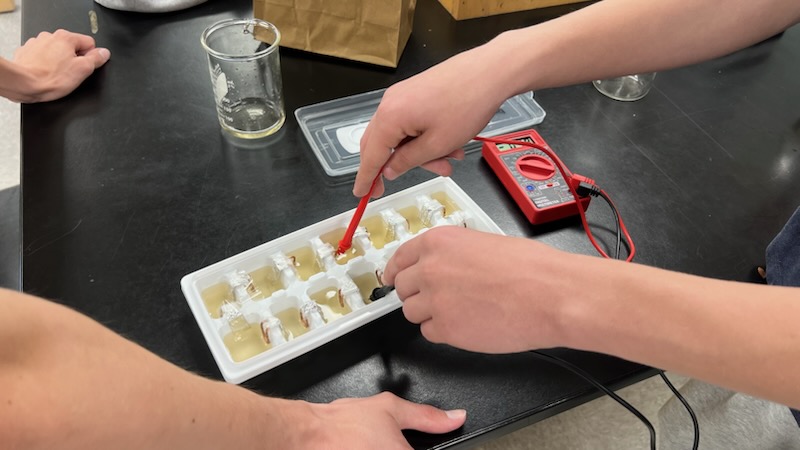
Diabetes affects society, FC students and faculty share their stories
Diabetes is a metabolic disease in which the body’s inability to produce any or enough insulin causes elevated levels of glucose in the blood. Uncontrolled diabetes can lead to kidney disease, vision loss, loss of limbs, heart problems and even death. 48.3 percent of the U.S. population, 25.8 million people are learning to live with diabetes. Seven million of these people do not know they have the disease.
Though we might not know it, there are several families in our school who have faced the daily struggle of diabetes.
Staff member, Valentine Rivera, was diagnosed with type two diabetes at age 50. He took the diagnosis as a sign he needed to change his lifestyle and start living up to better health expectations.
“There are many members in my family that are diabetic,” Rivera said. “It was scary at first because of the fact that several of my relatives had passed away being diabetic. At that point I knew I had to change my life.”
Rivera began classes at Kaiser Medical Center where he was taught to cope with diabetes by exercising, and dieting. He learned when and what to eat, and when to take his medication. He thanks the Lord for the continual blessings and preserves to take advantage of the days he has been given.
“It’s hard to diet and stay in shape but it takes a lot of determination and willpower to stick to this regiment,” Rivera said. “There were times where I would do well and times where I wouldn’t. For instance with the holidays coming up I have to watch what I eat. My wife helps me with a chart that we have to record what I?m doing and what my intake is. I test my blood twice a day daily. Type two diabetes is a disease that you can cope with and there?s no reason that you can?t live a long, normal life. I?m blessed that I have been able to tackle this on the positive side. Some people dwell on it and give up. I believe that the Lord has a reason for me to be here and that’s how I take it.”
Senior Trevor Beal found out the news when he went in for an appointment for a broken ankle in 2009. The routine blood tests and blood sugar evaluation he received came back with a new discovery-he had diabetes.
“In the coming days and weeks, I learned that I was in a battle for my life that could only be won through discipline and hard work,” Beal said. “There is no easy fix for our disease, current methods of management are very functional and will provide great A1C results if used properly. It is up to us individually to not lose the fight and to maintain a life of medical normality.”
Sophomore, Sydney Belmont, was diagnosed with type one diabetes at 22 months.
She receives daily blood sugar tests three to four times a day but goes through her day as any other high schooler would. She feels that testing so frequently is bothersome.
“When I was younger pricking my finger would be slightly painful,” Belmont said, “But now it doesn’t affect me because my fingers are callused.”
First grader, Julianna Briggs is another student who was diagnosed with type one diabetes at a very young age. Shannon Briggs, Julianna’s mother, praises God for sparing her life.
“Lala {Julianna} was tested every 2-3 hours, 24 hours a day,” Briggs said. “We were afraid her blood glucose level would go low, causing a seizure and effecting her overall brain development. She received about 6-9 shots of insulin a day, but adjusted and never complained.”
Lala {Julianna} was tested every 2-3 hours, 24 hours a day. We were afraid her blood glucose level would go low, causing a seizure and effecting her overall brain development. She received about 6-9 shots of insulin a day, but adjusted and never complained. –Shannon Briggs
Vickey Belmont, mother of Sydney, and Shannon Briggs are the primary go to person for their daughter’s diabetes. Their stories are similar and both can relate with the struggle of wanting their child to have a normal life.
“Sydney was an active toddler,” Vickey said. “For the first 22 months, she was a normal girl and wanted to play all the time. One day her whole life was changed in a blink of an eye. I started to notice that something was different with Sydney. One day she would be up running around like a normal two year old and the next day she would be laying around lethargic. My mother’s intuition told me that something wasn’t right.”
This was almost the same exact situation for, at the time, one year old Julianna Briggs.
“Julianna was a very healthy five pound baby,” Shannon said. “Two weeks after her first birthday my husband and I noticed a change in her health and behavior. For three consecutive days she was sleeping more than usual, nursing more frequently, and overall very weak. At one point, she couldn’t lift her head off of my shoulder. Following a doctor’s visit that gave us no real diagnosis, we felt like she needed to go to Valley Children’s Hospital.
These two families found out about their daughter’s diagnosis in a way that was said to be terrifying. The conditions that Sydney and Lala were in was daunting.
On September 4, 2001, Sydney started her day throwing up. The previous week she had been taken into the doctors three separate times. Vickey was to give her the medicine if she still seemed sick, but she did not get any better.
“When I took her back to the doctor, he said it was just a reaction to the medicine,” Vickey said. “Being the mother I am, I knew that Sydney was not acting like her normal self and I took her home, knowing something was terribly wrong. By the time I got a hold of another doctor and rushed her in, she was gray, lifeless, and throwing up blood.”
“I was scared to death that I would lose my baby girl. She was so dehydrated that the doctor had to use a needle to extract urine from her bladder. The doctor came and said, ‘She is in ketoacidosis and you need to rush her to the hospital; we don?t have time for an ambulance.'”
With her husband still at work, Vickey’s parents drove them to the hospital going at speeds of 90 miles an hour. Vickey, in total apprehension, was in the front seat shaking Sydney to keep her awake, screaming to her father that he needed to go faster. She called her husband, Scott, to tell him that she was rushing to the hospital.
“When we arrived at the emergency, I swooped Sydney up in my arms and ran to the door,” Vickey said. “It did not open so I banged on the glass door trying to get them to open it up. They opened the door and took my seemingly lifeless daughter from my arms. I remember seeing her little body on this huge bed and it made me sad seeing her just lying there.”
Vickey’s uncle, Steve, heard her husband’s call over the radio because Scott and him work for the same company. Scott came five minutes after Steve did. She was relieved she was not alone, but was saddened again when having to retell her husband what was happening. Then the doctor walked out and told the Belmont family that Sydney was diagnosed with type 1 diabetes.
The Briggs family had a faster diagnosis but was still frightened of what was happening with their child. Shortly after they arrived to the emergency room, a finger prick indicated that Lala had type 1 diabetes. At diagnosis her blood sugar level was seven times higher than a normal blood sugar level. She was severely dehydrated and hours away from a coma. She spent three days in the intensive care unit and two more days on the regular hospital floor.
“We praised God for sparing her life, but left the hospital feeling completely overwhelmed and ill equipped to begin the intensive insulin therapy required daily for Lala’s well-being,” Briggs said. “We went from feeling confident and secure in providing care for our three children, to wondering if we could keep our daughter alive.
“Less than 1% of type 1 diabetics are diagnosed as young as Lala. She was not walking or talking which made her treatment even more difficult. Because she was so small when she was diagnosed she was given diluted insulin. At that time only two labs in the Central Valley could produce diluted insulin.”
Both girls stayed in the hospital for a few days and their parents were given diabetes education and training. In both cases after they were trained, they were sent home to live this new way of life, feeling completely overwhelmed and under trained.
“We have cried lots of tears and gone through many trials as well as needles, vials and all the other paraphernalia that goes with being a diabetic,” Vickey said. “Having a child with diabetes is scary, exhausting, and stressful. Although it is something you can live with, it changes the lives of the family lifestyle.”
These girls have lived their whole life with diabetes and continue to grow and go along with everyday life as any normal person would. Sydney likes to play volleyball and is currently on the FC cheer team. Lala loves horseback riding and also does horse vaulting.
“As difficult as this diagnosis was to grasp, it has been a blessing,” Shannon said. “Our family has become advocates for people living with type 1 diabetes. I started a support group for parents of newly diagnosed children and also serve as a mentor and advocate for the Juvenile Diabetes Research Foundation (JDRF).
“In 2013 Lala was selected to attend Children’s Congress in Washington, D.C., in order to push Congress to continue funding type 1 diabetes. She was able to tell her story to U.S. Congress members, and she met the Vice President, Joe Biden. We also participate in the JDRF’s walk for the cure held annually at Woodward Park.”
The Feather staff and those interviewed encourage students to not fear the disease but find those who can share their experience, helping with new diagnosis.
These writers can be reached via Twitter: @_nataliatorres1 or through email at [email protected] and @nhudecek16 and [email protected].
For more features, read the Dec. 1 article, Fall Festivus offers fellowship, camaraderie.






